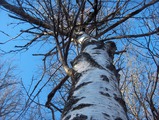6102 Betula L.
- L., Sp. Pl.: 982 (1753).
- Excluded: Betula occidentalis (see B. neoalaskana below).
Notes: There is no comparatively modern taxonomic survey of the birches covering the entire circumpolar area. Furlow (1997) treated Betula for North America without much regard to other regions, as did Walters (1993) for Europe, Czerepanov (1966) for the Russian Arctic, Shemberg (1992) for Siberia, and Nedolushko (1996a) for the Russian Far East. These accounts suggest, however, that northeastern Asia and North America have no tree-forming birch species in common and probably not northwestern Europe and northeastern North America (including Greenland) either. A fairly recent (rapid) evolution of the northern taxa is suggested.
Tzvelev (2002) surveyed the birches of European Russia. He recognized 22 species and eight hybrids ('nothospecies') in three sections. He reported the following to be present in or close to the Arctic (the latter marked by '?'): his sect. Betula with B. callosa Notø, B. concinna Gunnarsson, B. coriacea Gunnarsson, B. czerepanovii N.I. Orlova, ?B. krylovii G.V. Krylov, B. kusmisscheffii (Regel) Sukaczev, B. pubescens Ehrh., B. subarctica N.I. Orlova, ?B. x kateninii Tzvelev (B. callosa x pendula), and B. x intermedia Thomas ex Gaudin (B. nana x pubescens); his sect. Humiles Koch with B. humilis Schrank.; and his sect. Apterycaryon Spach (sect. Nanae (Regel) Kusen.) with B. nana L., B. sukatschewii Soczava, B. tundrarum Perfil., and B. alpestris Fr. We have not been able to relate Tzvelev's treatment to other treatments of the genus or to indicate where all of Tzvelev's species names belong within the more widely circumscribed species accepted by other authors.
A molecular study based on nuclear (ADH) and chloroplast (matK) sequences (Järvinen et al. 2004) included a selection of species from the majority of sections. They found incongruence between the phylogenies based on nuclear and chloroplast data. The matK based phylogeny identified two groups, one of three North American species (two from their sect. Betulenta and B. papyrifera from sect. Betula), another with all the others from their sect. Chamaebetula (B. fruticosa, B. humilis, B. nana), sect. Neurobetula (B. ermanii), sect. Betula (e.g., B. pendula and B. pubescens), and sect. Betulaster (B. maximowicziana). The ADH based phylogeny identified several groups with good support: one with the non-arctic sect. Betulenta and Betulaster, one with four species from four sections (B. fruticosa, B. ermanii, B. humilis, and a short allele B. pubescens), one with B. nana and a long-allele B. pubescens, and one with mainly sect. Betula species, (e.g. B. papyrifera and B. pendula). The most interesting results for the arctic birches are: (a) that the shrubby representatives appear in several different lineages, they do not constitute a monophyletic group, and (b) that the northern European B. pubescens seems to be an allopolyploid with probable participation of B. nana.
Two subsequent molecular studies are Li et al. (2005, based on nrDNA) and Schenk et al. (2008, based on AFLP). Both studies have their focus mainly on more southern species, omitting the majority of northern boreal and arctic ones. What is suggested by the last-mentioned study is: (a) that the previous section system probably must be revised and that all included northern species may belong to one section, sect. Betula, (b) that B. pendula, B. platyphylla, and B. populifolia constitute a monophyletic group with bootstrap support, (c) that B. papyrifera, B. pubescens, and the shrubby B. nana and B. pumila belong to another group but without bootstrap support, and (d) that B. humilis (= B. fruticosa) may belong to a separate group together with more southern Asian species (i.e., B. costata, B. ermanii, and B. davurica).
The referred molecular studies, like a few other recent ones (e.g., Eidesen 2007, based on AFLP), is deplorably short on morphology and thereby on justifications for assigning names to their samples. Investigations combining molecules, cytology, and morphology are needed before the structure in the messy genus Betula is clarified.
Higher Taxa
- Betulaceae [61,family]
Lower Taxa (Show all)
- The Betula pendula aggregate B. neoalaskana, B. pendula, B. platyphylla
- Betula pendula
- Betula platyphylla
- Betula neoalaskana
- The Betula papyrifera aggregate B. kenaica, B. papyrifera
- Betula papyrifera
- Betula kenaica
- The Betula pubescens aggregate B. minor, B. pubescens
- Betula pubescens
- Betula minor
- The Betula fruticosa aggregate B. fruticosa, B. pumila
- Betula fruticosa
- Betula pumila
- Betula glandulosa
- Betula divaricata
- Betula nana
